Analysis of Management Organization and Globalization Principles
VerifiedAdded on 2020/03/07
|7
|1496
|64
Essay
AI Summary
This essay delves into the critical concepts of management organization and globalization, emphasizing the significance of organizational culture. It begins by highlighting the importance of culture in shaping employee behavior, morale, and overall company success, using the Zappos example to illustrate the benefits of building a strong organizational culture. The essay then explores four distinct types of organizational cultures: clan, hierarchy, adhocracy, and market, providing detailed characteristics and leadership styles associated with each. The core of the essay focuses on the interplay between culture and strategy, arguing that a company's culture significantly impacts the implementation of its strategies. It emphasizes the need for alignment between the two, suggesting that flexible and unified cultures facilitate effective strategy execution. The essay concludes by reiterating the crucial role of organizational culture in defining company values and achieving strategic objectives, urging organizations to adapt their culture to align with their strategies for optimal results. References to key academic sources and video clips support the analysis.
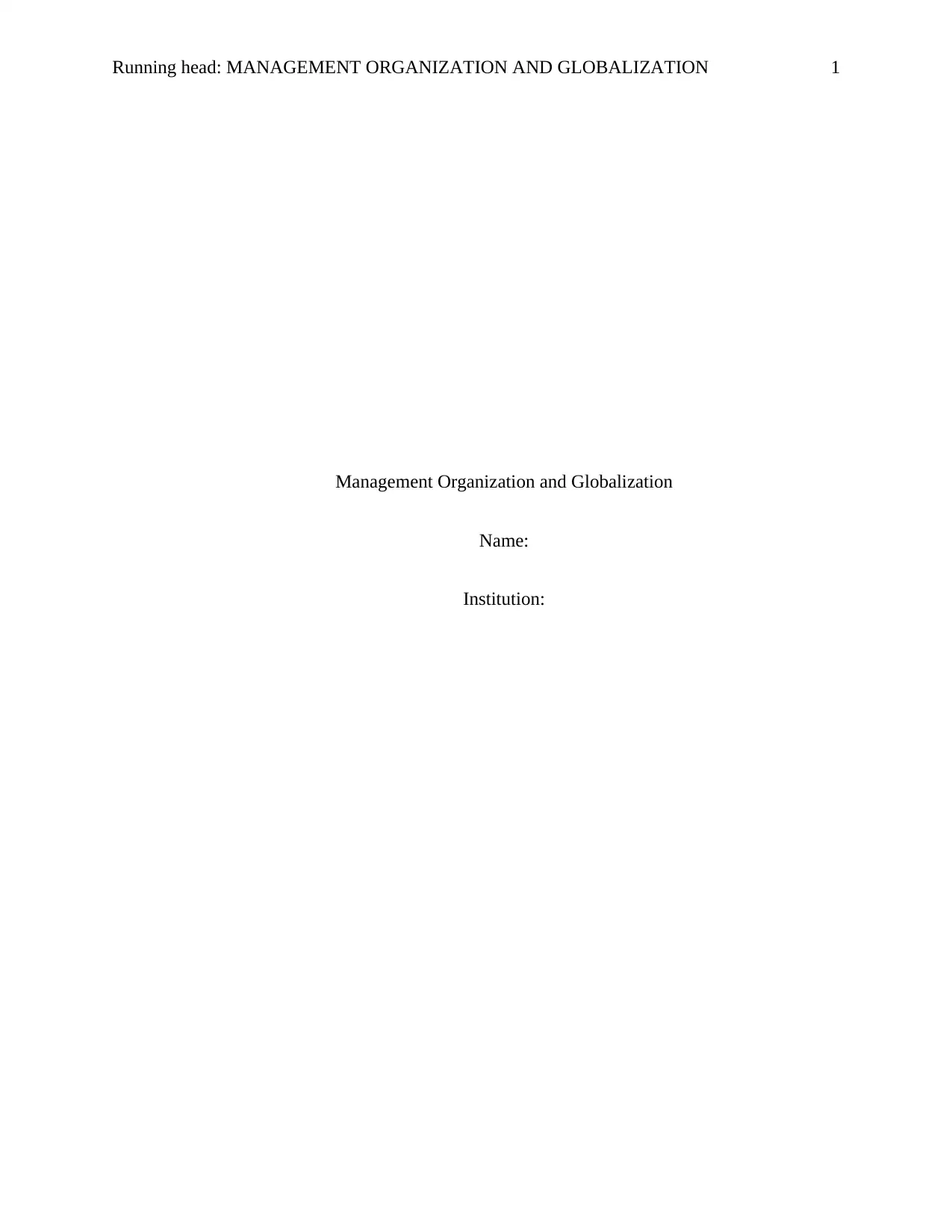
Running head: MANAGEMENT ORGANIZATION AND GLOBALIZATION 1
Management Organization and Globalization
Name:
Institution:
Management Organization and Globalization
Name:
Institution:
Paraphrase This Document
Need a fresh take? Get an instant paraphrase of this document with our AI Paraphraser
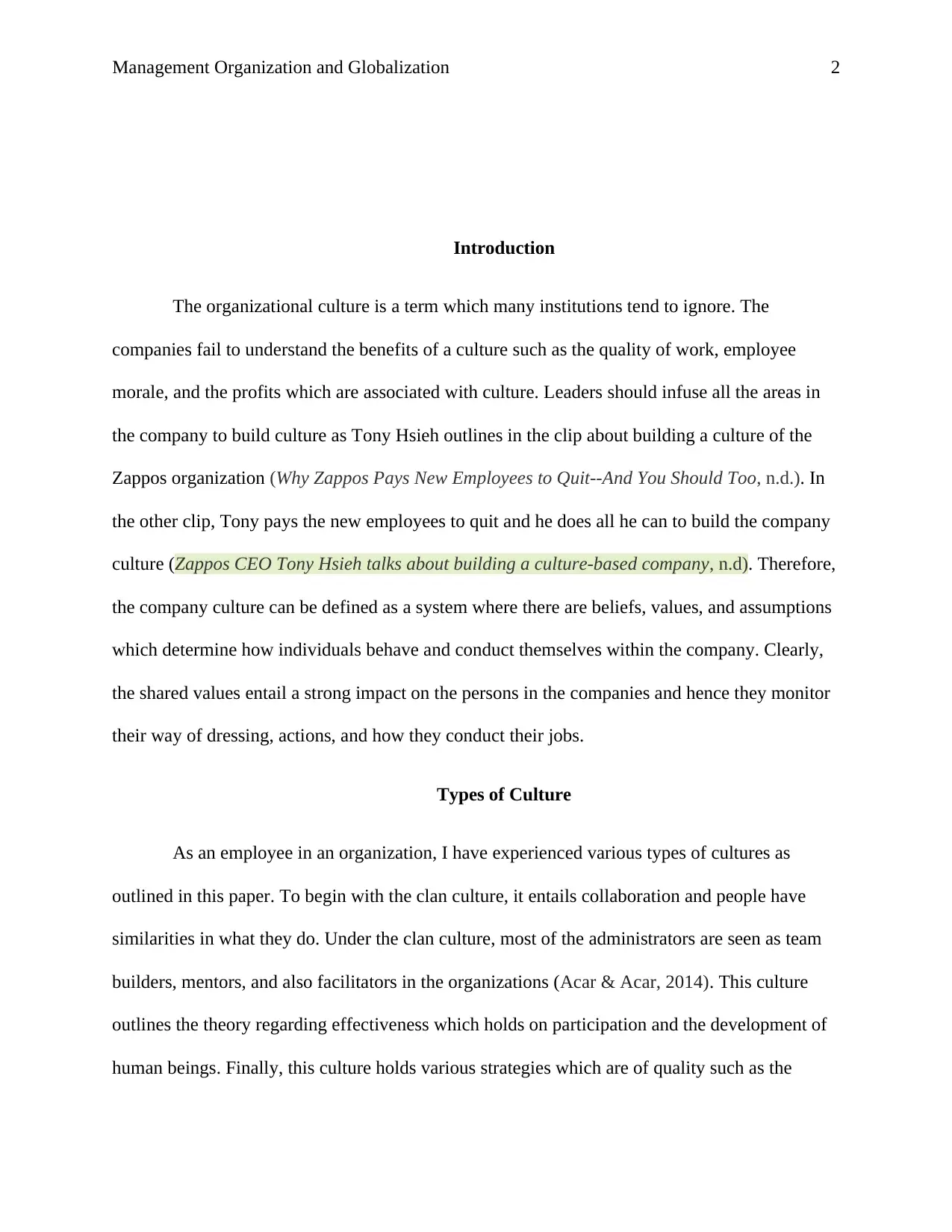
Management Organization and Globalization 2
Introduction
The organizational culture is a term which many institutions tend to ignore. The
companies fail to understand the benefits of a culture such as the quality of work, employee
morale, and the profits which are associated with culture. Leaders should infuse all the areas in
the company to build culture as Tony Hsieh outlines in the clip about building a culture of the
Zappos organization (Why Zappos Pays New Employees to Quit--And You Should Too, n.d.). In
the other clip, Tony pays the new employees to quit and he does all he can to build the company
culture (Zappos CEO Tony Hsieh talks about building a culture-based company, n.d). Therefore,
the company culture can be defined as a system where there are beliefs, values, and assumptions
which determine how individuals behave and conduct themselves within the company. Clearly,
the shared values entail a strong impact on the persons in the companies and hence they monitor
their way of dressing, actions, and how they conduct their jobs.
Types of Culture
As an employee in an organization, I have experienced various types of cultures as
outlined in this paper. To begin with the clan culture, it entails collaboration and people have
similarities in what they do. Under the clan culture, most of the administrators are seen as team
builders, mentors, and also facilitators in the organizations (Acar & Acar, 2014). This culture
outlines the theory regarding effectiveness which holds on participation and the development of
human beings. Finally, this culture holds various strategies which are of quality such as the
Introduction
The organizational culture is a term which many institutions tend to ignore. The
companies fail to understand the benefits of a culture such as the quality of work, employee
morale, and the profits which are associated with culture. Leaders should infuse all the areas in
the company to build culture as Tony Hsieh outlines in the clip about building a culture of the
Zappos organization (Why Zappos Pays New Employees to Quit--And You Should Too, n.d.). In
the other clip, Tony pays the new employees to quit and he does all he can to build the company
culture (Zappos CEO Tony Hsieh talks about building a culture-based company, n.d). Therefore,
the company culture can be defined as a system where there are beliefs, values, and assumptions
which determine how individuals behave and conduct themselves within the company. Clearly,
the shared values entail a strong impact on the persons in the companies and hence they monitor
their way of dressing, actions, and how they conduct their jobs.
Types of Culture
As an employee in an organization, I have experienced various types of cultures as
outlined in this paper. To begin with the clan culture, it entails collaboration and people have
similarities in what they do. Under the clan culture, most of the administrators are seen as team
builders, mentors, and also facilitators in the organizations (Acar & Acar, 2014). This culture
outlines the theory regarding effectiveness which holds on participation and the development of
human beings. Finally, this culture holds various strategies which are of quality such as the
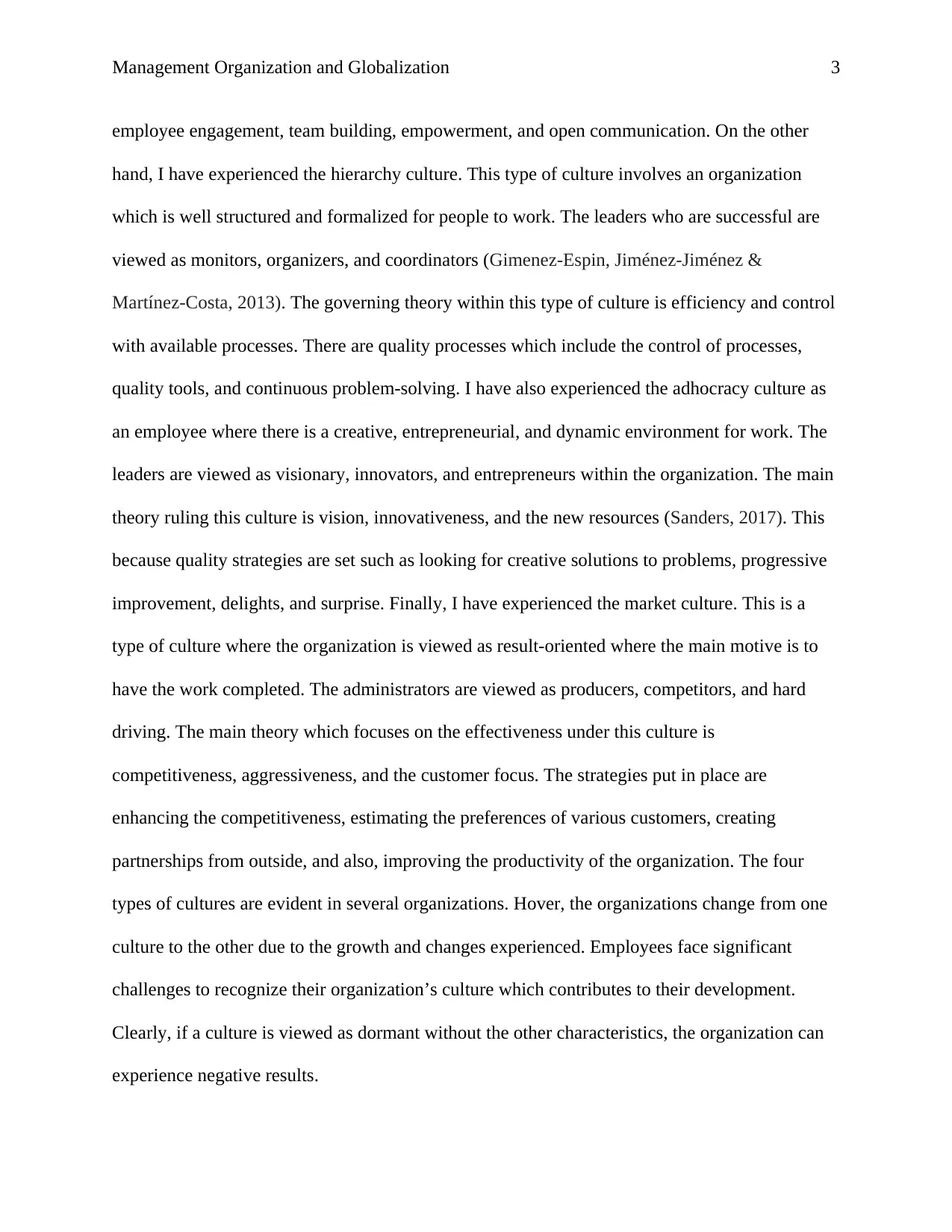
Management Organization and Globalization 3
employee engagement, team building, empowerment, and open communication. On the other
hand, I have experienced the hierarchy culture. This type of culture involves an organization
which is well structured and formalized for people to work. The leaders who are successful are
viewed as monitors, organizers, and coordinators (Gimenez-Espin, Jiménez-Jiménez &
Martínez-Costa, 2013). The governing theory within this type of culture is efficiency and control
with available processes. There are quality processes which include the control of processes,
quality tools, and continuous problem-solving. I have also experienced the adhocracy culture as
an employee where there is a creative, entrepreneurial, and dynamic environment for work. The
leaders are viewed as visionary, innovators, and entrepreneurs within the organization. The main
theory ruling this culture is vision, innovativeness, and the new resources (Sanders, 2017). This
because quality strategies are set such as looking for creative solutions to problems, progressive
improvement, delights, and surprise. Finally, I have experienced the market culture. This is a
type of culture where the organization is viewed as result-oriented where the main motive is to
have the work completed. The administrators are viewed as producers, competitors, and hard
driving. The main theory which focuses on the effectiveness under this culture is
competitiveness, aggressiveness, and the customer focus. The strategies put in place are
enhancing the competitiveness, estimating the preferences of various customers, creating
partnerships from outside, and also, improving the productivity of the organization. The four
types of cultures are evident in several organizations. Hover, the organizations change from one
culture to the other due to the growth and changes experienced. Employees face significant
challenges to recognize their organization’s culture which contributes to their development.
Clearly, if a culture is viewed as dormant without the other characteristics, the organization can
experience negative results.
employee engagement, team building, empowerment, and open communication. On the other
hand, I have experienced the hierarchy culture. This type of culture involves an organization
which is well structured and formalized for people to work. The leaders who are successful are
viewed as monitors, organizers, and coordinators (Gimenez-Espin, Jiménez-Jiménez &
Martínez-Costa, 2013). The governing theory within this type of culture is efficiency and control
with available processes. There are quality processes which include the control of processes,
quality tools, and continuous problem-solving. I have also experienced the adhocracy culture as
an employee where there is a creative, entrepreneurial, and dynamic environment for work. The
leaders are viewed as visionary, innovators, and entrepreneurs within the organization. The main
theory ruling this culture is vision, innovativeness, and the new resources (Sanders, 2017). This
because quality strategies are set such as looking for creative solutions to problems, progressive
improvement, delights, and surprise. Finally, I have experienced the market culture. This is a
type of culture where the organization is viewed as result-oriented where the main motive is to
have the work completed. The administrators are viewed as producers, competitors, and hard
driving. The main theory which focuses on the effectiveness under this culture is
competitiveness, aggressiveness, and the customer focus. The strategies put in place are
enhancing the competitiveness, estimating the preferences of various customers, creating
partnerships from outside, and also, improving the productivity of the organization. The four
types of cultures are evident in several organizations. Hover, the organizations change from one
culture to the other due to the growth and changes experienced. Employees face significant
challenges to recognize their organization’s culture which contributes to their development.
Clearly, if a culture is viewed as dormant without the other characteristics, the organization can
experience negative results.
⊘ This is a preview!⊘
Do you want full access?
Subscribe today to unlock all pages.

Trusted by 1+ million students worldwide
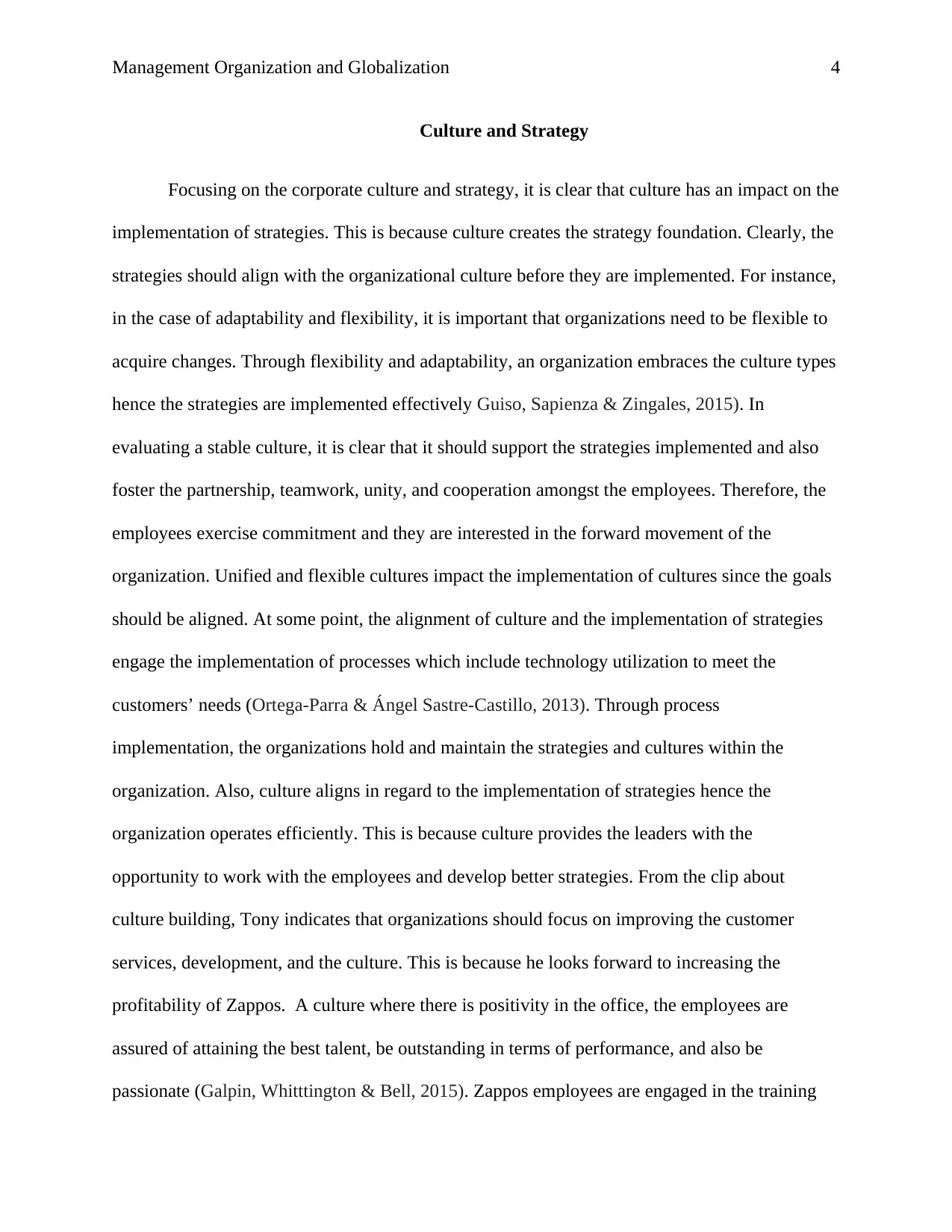
Management Organization and Globalization 4
Culture and Strategy
Focusing on the corporate culture and strategy, it is clear that culture has an impact on the
implementation of strategies. This is because culture creates the strategy foundation. Clearly, the
strategies should align with the organizational culture before they are implemented. For instance,
in the case of adaptability and flexibility, it is important that organizations need to be flexible to
acquire changes. Through flexibility and adaptability, an organization embraces the culture types
hence the strategies are implemented effectively Guiso, Sapienza & Zingales, 2015). In
evaluating a stable culture, it is clear that it should support the strategies implemented and also
foster the partnership, teamwork, unity, and cooperation amongst the employees. Therefore, the
employees exercise commitment and they are interested in the forward movement of the
organization. Unified and flexible cultures impact the implementation of cultures since the goals
should be aligned. At some point, the alignment of culture and the implementation of strategies
engage the implementation of processes which include technology utilization to meet the
customers’ needs (Ortega-Parra & Ángel Sastre-Castillo, 2013). Through process
implementation, the organizations hold and maintain the strategies and cultures within the
organization. Also, culture aligns in regard to the implementation of strategies hence the
organization operates efficiently. This is because culture provides the leaders with the
opportunity to work with the employees and develop better strategies. From the clip about
culture building, Tony indicates that organizations should focus on improving the customer
services, development, and the culture. This is because he looks forward to increasing the
profitability of Zappos. A culture where there is positivity in the office, the employees are
assured of attaining the best talent, be outstanding in terms of performance, and also be
passionate (Galpin, Whitttington & Bell, 2015). Zappos employees are engaged in the training
Culture and Strategy
Focusing on the corporate culture and strategy, it is clear that culture has an impact on the
implementation of strategies. This is because culture creates the strategy foundation. Clearly, the
strategies should align with the organizational culture before they are implemented. For instance,
in the case of adaptability and flexibility, it is important that organizations need to be flexible to
acquire changes. Through flexibility and adaptability, an organization embraces the culture types
hence the strategies are implemented effectively Guiso, Sapienza & Zingales, 2015). In
evaluating a stable culture, it is clear that it should support the strategies implemented and also
foster the partnership, teamwork, unity, and cooperation amongst the employees. Therefore, the
employees exercise commitment and they are interested in the forward movement of the
organization. Unified and flexible cultures impact the implementation of cultures since the goals
should be aligned. At some point, the alignment of culture and the implementation of strategies
engage the implementation of processes which include technology utilization to meet the
customers’ needs (Ortega-Parra & Ángel Sastre-Castillo, 2013). Through process
implementation, the organizations hold and maintain the strategies and cultures within the
organization. Also, culture aligns in regard to the implementation of strategies hence the
organization operates efficiently. This is because culture provides the leaders with the
opportunity to work with the employees and develop better strategies. From the clip about
culture building, Tony indicates that organizations should focus on improving the customer
services, development, and the culture. This is because he looks forward to increasing the
profitability of Zappos. A culture where there is positivity in the office, the employees are
assured of attaining the best talent, be outstanding in terms of performance, and also be
passionate (Galpin, Whitttington & Bell, 2015). Zappos employees are engaged in the training
Paraphrase This Document
Need a fresh take? Get an instant paraphrase of this document with our AI Paraphraser
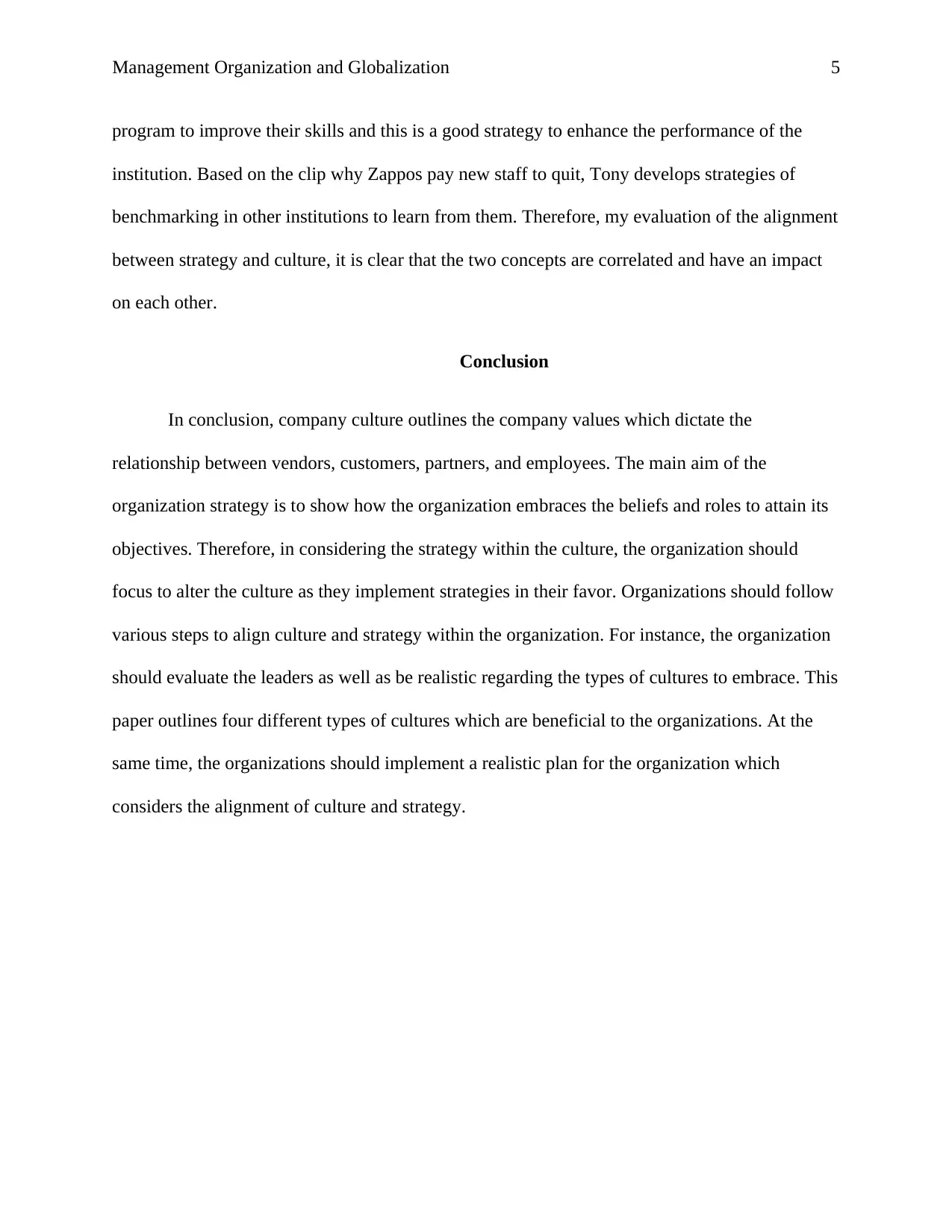
Management Organization and Globalization 5
program to improve their skills and this is a good strategy to enhance the performance of the
institution. Based on the clip why Zappos pay new staff to quit, Tony develops strategies of
benchmarking in other institutions to learn from them. Therefore, my evaluation of the alignment
between strategy and culture, it is clear that the two concepts are correlated and have an impact
on each other.
Conclusion
In conclusion, company culture outlines the company values which dictate the
relationship between vendors, customers, partners, and employees. The main aim of the
organization strategy is to show how the organization embraces the beliefs and roles to attain its
objectives. Therefore, in considering the strategy within the culture, the organization should
focus to alter the culture as they implement strategies in their favor. Organizations should follow
various steps to align culture and strategy within the organization. For instance, the organization
should evaluate the leaders as well as be realistic regarding the types of cultures to embrace. This
paper outlines four different types of cultures which are beneficial to the organizations. At the
same time, the organizations should implement a realistic plan for the organization which
considers the alignment of culture and strategy.
program to improve their skills and this is a good strategy to enhance the performance of the
institution. Based on the clip why Zappos pay new staff to quit, Tony develops strategies of
benchmarking in other institutions to learn from them. Therefore, my evaluation of the alignment
between strategy and culture, it is clear that the two concepts are correlated and have an impact
on each other.
Conclusion
In conclusion, company culture outlines the company values which dictate the
relationship between vendors, customers, partners, and employees. The main aim of the
organization strategy is to show how the organization embraces the beliefs and roles to attain its
objectives. Therefore, in considering the strategy within the culture, the organization should
focus to alter the culture as they implement strategies in their favor. Organizations should follow
various steps to align culture and strategy within the organization. For instance, the organization
should evaluate the leaders as well as be realistic regarding the types of cultures to embrace. This
paper outlines four different types of cultures which are beneficial to the organizations. At the
same time, the organizations should implement a realistic plan for the organization which
considers the alignment of culture and strategy.
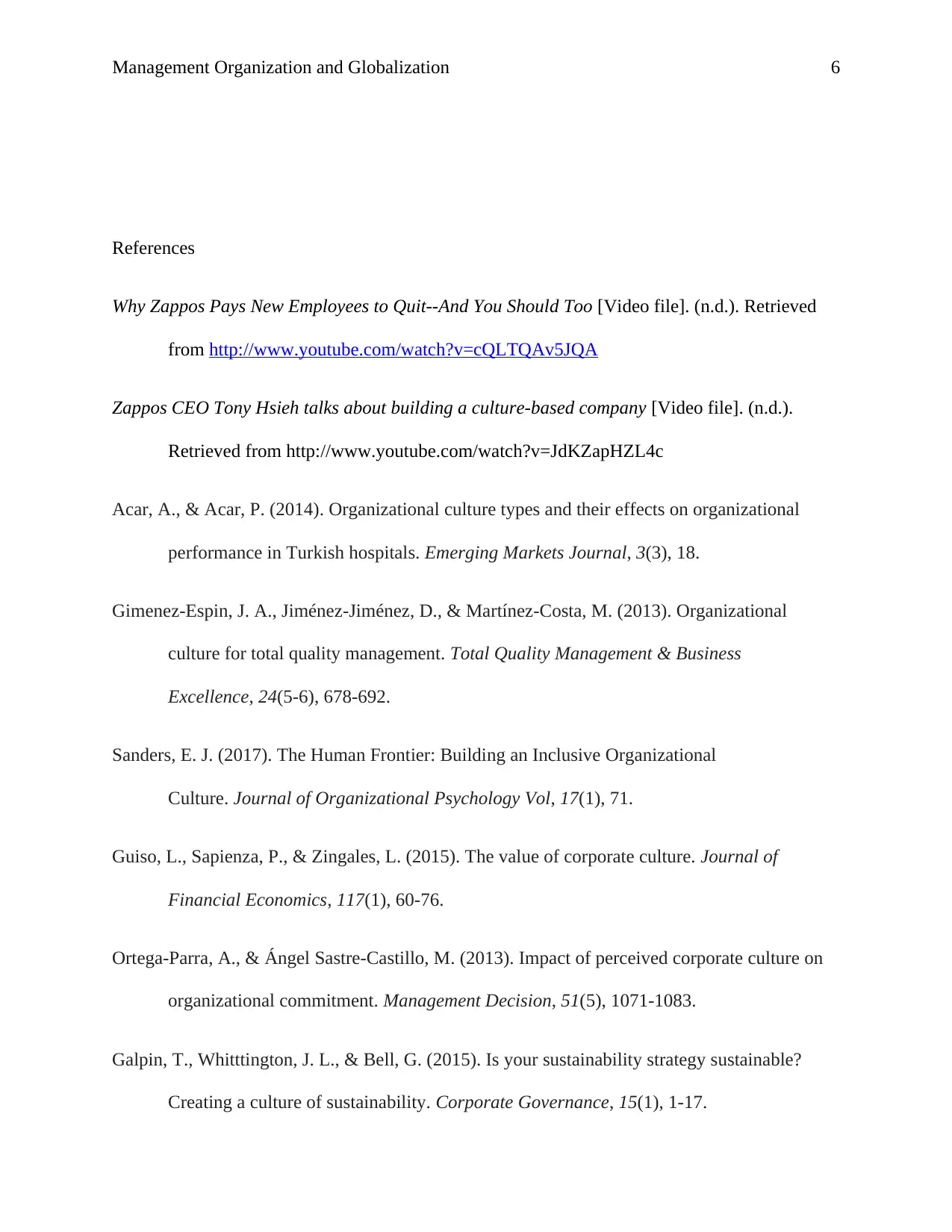
Management Organization and Globalization 6
References
Why Zappos Pays New Employees to Quit--And You Should Too [Video file]. (n.d.). Retrieved
from http://www.youtube.com/watch?v=cQLTQAv5JQA
Zappos CEO Tony Hsieh talks about building a culture-based company [Video file]. (n.d.).
Retrieved from http://www.youtube.com/watch?v=JdKZapHZL4c
Acar, A., & Acar, P. (2014). Organizational culture types and their effects on organizational
performance in Turkish hospitals. Emerging Markets Journal, 3(3), 18.
Gimenez-Espin, J. A., Jiménez-Jiménez, D., & Martínez-Costa, M. (2013). Organizational
culture for total quality management. Total Quality Management & Business
Excellence, 24(5-6), 678-692.
Sanders, E. J. (2017). The Human Frontier: Building an Inclusive Organizational
Culture. Journal of Organizational Psychology Vol, 17(1), 71.
Guiso, L., Sapienza, P., & Zingales, L. (2015). The value of corporate culture. Journal of
Financial Economics, 117(1), 60-76.
Ortega-Parra, A., & Ángel Sastre-Castillo, M. (2013). Impact of perceived corporate culture on
organizational commitment. Management Decision, 51(5), 1071-1083.
Galpin, T., Whitttington, J. L., & Bell, G. (2015). Is your sustainability strategy sustainable?
Creating a culture of sustainability. Corporate Governance, 15(1), 1-17.
References
Why Zappos Pays New Employees to Quit--And You Should Too [Video file]. (n.d.). Retrieved
from http://www.youtube.com/watch?v=cQLTQAv5JQA
Zappos CEO Tony Hsieh talks about building a culture-based company [Video file]. (n.d.).
Retrieved from http://www.youtube.com/watch?v=JdKZapHZL4c
Acar, A., & Acar, P. (2014). Organizational culture types and their effects on organizational
performance in Turkish hospitals. Emerging Markets Journal, 3(3), 18.
Gimenez-Espin, J. A., Jiménez-Jiménez, D., & Martínez-Costa, M. (2013). Organizational
culture for total quality management. Total Quality Management & Business
Excellence, 24(5-6), 678-692.
Sanders, E. J. (2017). The Human Frontier: Building an Inclusive Organizational
Culture. Journal of Organizational Psychology Vol, 17(1), 71.
Guiso, L., Sapienza, P., & Zingales, L. (2015). The value of corporate culture. Journal of
Financial Economics, 117(1), 60-76.
Ortega-Parra, A., & Ángel Sastre-Castillo, M. (2013). Impact of perceived corporate culture on
organizational commitment. Management Decision, 51(5), 1071-1083.
Galpin, T., Whitttington, J. L., & Bell, G. (2015). Is your sustainability strategy sustainable?
Creating a culture of sustainability. Corporate Governance, 15(1), 1-17.
⊘ This is a preview!⊘
Do you want full access?
Subscribe today to unlock all pages.

Trusted by 1+ million students worldwide
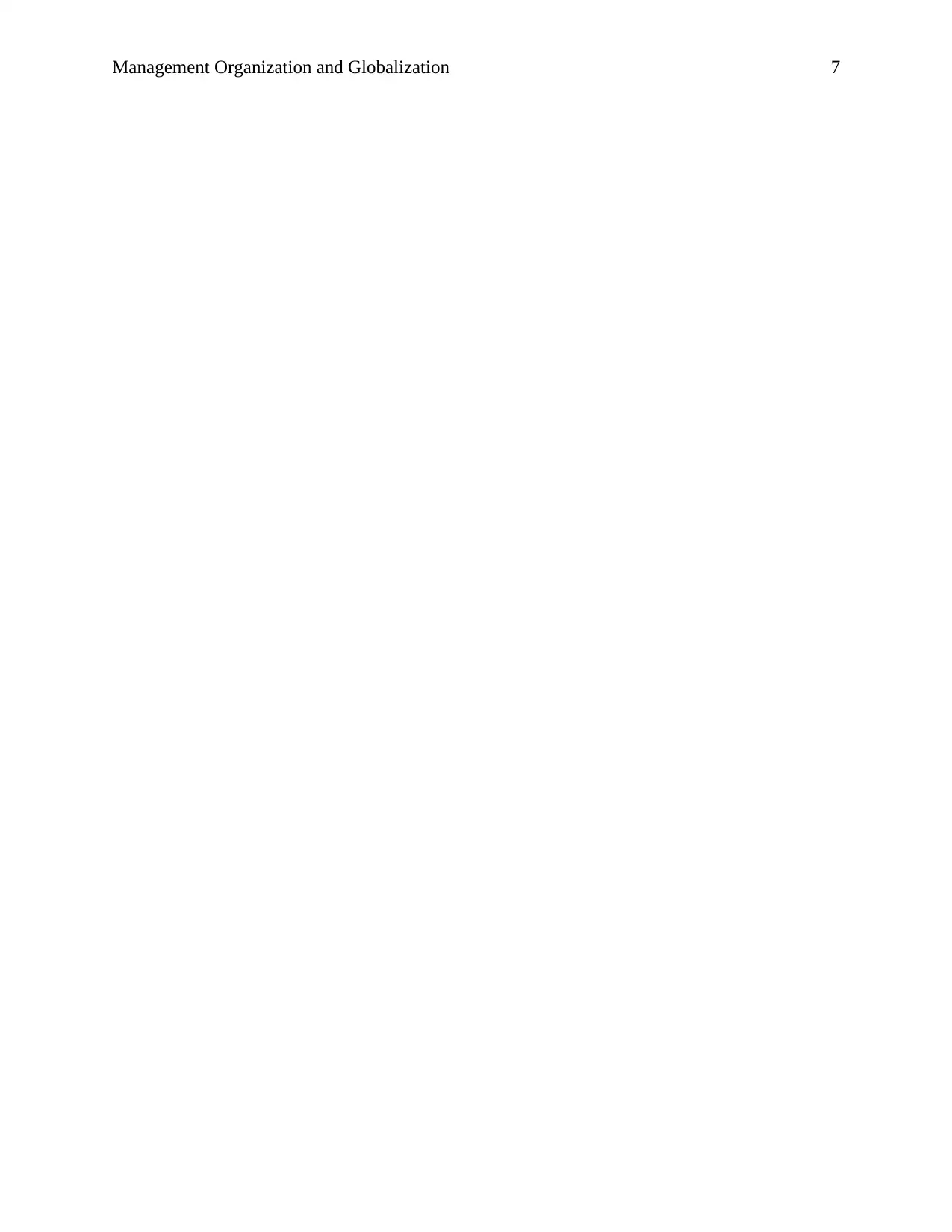
Management Organization and Globalization 7
1 out of 7
Related Documents
Your All-in-One AI-Powered Toolkit for Academic Success.
+13062052269
info@desklib.com
Available 24*7 on WhatsApp / Email
![[object Object]](/_next/static/media/star-bottom.7253800d.svg)
Unlock your academic potential
Copyright © 2020–2025 A2Z Services. All Rights Reserved. Developed and managed by ZUCOL.





